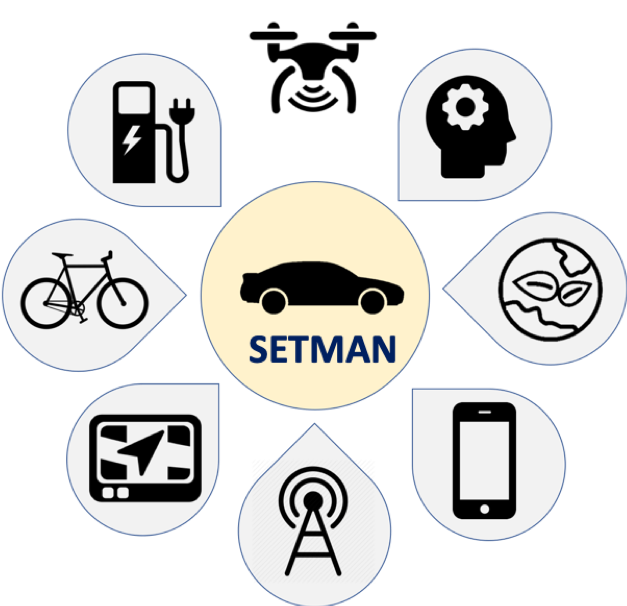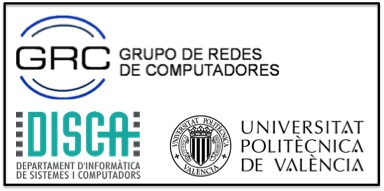"Solutions for efficient vehicular traffic management based on networked systems and services" (RTI2018-096384-B-I00)
The automotive industry and the research community are currently introducing profound changes in order to achieve the ITS vision, which embraces smarter, greener, safer, and more efficient mobility. The first requirement for ITS to become a reality is having solid and cost-effective communication systems to provide seamless communication between the different actors, i.e., vehicles, drivers, infrastructure, and the environment, offering what is called V2X communication. In fact, to promote the adoption of Intelligent Transportation Systems, many national and international research projects, as well as corporate projects and industry research groups, have emerged in recent years, focusing their efforts in proposing and standardizing an ITS communications architecture. As for transport issues, governments and public authorities are focusing all their efforts towards an integrated, sustainable, and robust transport system. Particularly, they seek to: (i) a more efficient and effective traffic management, as well as deployment and maintenance of infrastructure elements, (ii) enhance safety for users, (iii) improve health moving towards pollution and emission-free, low-noise transport and mobility solutions, and (iv) increase the transport system’s resilience and security. Other important issue to account for is people, i.e., their demands, needs, and behaviors, favoring their inclusion and access. We consider that the use of Data mining and data analytics can help us to better understand and anticipate the dynamics of mobility and transport demand, accounting for all citizens, industry and commerce. Additionally, we will be able to update and enhance the knowledge toolbox (datasets, models, foresight, indicators, and new tools) for the impact assessment of both vehicle and citizen mobility solutions and policies.Looking further into the ITS future, it is expected that, over the next decades, autonomous vehicle solutions will become widely available. In fact, the first vehicle models integrating autonomous driving technology have recently reached the market and, according to a report from BI Intelligence, there will be 10 million cars with self-driving features by 2020.
Despite the future developments described above are indeed exciting, we should not forget that most developed countries are characterized by profound asymmetries when comparing the largest metropolis against the most remote rural areas and even secondary roads. In this project we do not forget about such heterogeneity, and also aim at improving traffic flow and traffic security in unattended/poorly connected areas. To meet this goal, we propose a combination of the emerging UAV-based mobile infrastructure, which can be deployed on demand, and vehicle-to-vehicle (V2V) communications based on Delay-Tolerant Networking (DTN), to disseminate critical information among drivers, especially when traffic is sparse.
To understand the reasoning behind this proposal, we took into consideration that Unmanned Aerial Vehicles (UAVs), especially those belonging to the multirotor family, have recently experienced an unprecedented growth, with countless application areas in the near future. Our research group has been working on this topic for the past 4 years, having already achieved significant advances, as proven by the different publications generated. UAVs can be useful in the context of vehicular networks by allowing to quickly reach areas with low network connectivity, and provide valuable alerts to drivers about dangerous conditions (e.g. icy road, accident, crumbling stone), which typically require an explicit intervention of authorities by deploying traffic personnel to the site. The on-demand assignment of UAVs to such places allows reaching them in a very short time period, while avoiding having to assign traffic personnel to the site. Such reduced time overhead can be critical when very dangerous situations put people’s lives at stake (e.g. a bridge collapses during the night), thus allowing to minimize casualties. Additionally, vehicles are also able to provide information, including failures detected, promoting solutions to different problems between drivers and their vehicles based on data analysis and information awareness. Notice that the mining of all data generated by the different drivers and their corresponding vehicles may return valuable information to system administrators and users themselves by providing global insight.
Overall, the objetive of the SETMAN project will integrate related research topics in order to obtain a complete set of driving assistance solutions: (i) centralized traffic management, (ii) advanced & communications-enabled on board unit, (iii) mobile roadside units, and (iv) driver & vehicle data analytics. Next, we elaborate on these four research topics.
(i) Centralized traffic management:
Aerial traffic has been under strict management for several decades, which has allowed regulating such traffic in an efficient and optimized manner. Basically, each airport or group of airports in a same area are under the control of a same Controlled Traffic Region (CTR) that extends from the surface up to a specified height, which is established to protect air traffic operating to and from that airport. This way, aircrafts can only fly in this space after receiving a specific clearance from air traffic control, and following its indications. In this project we propose assimilating the CTR paradigm to metropolitan areas by developing a Metropolitan Road Traffic Control (MRTC) architecture that has the power to directly communicate and manage all vehicles. Differently from the aircraft CTR paradigm, though, the main goal is not to avoid collisions, since this is a task assigned to each vehicle independently. Instead, the goal is to regulate their routes in a centralized manner in order to achieve specific traffic regulation purposes, thus providing efficient mobility, as well as reducing congestion and CO2 emissions. To this end we have been collaborating with the City Hall of Valencia, and have been able to import real traffic data, and to model the travel times and congestion behavior for all the streets in the city (see our publications on this topic in section 3.3), being now in position to undertake this new challenge.
(ii) Advanced & communications-enabled on board units:
To make vehicles fully participate in future intelligent transportation systems, they should mandatorily be endowed with an advanced on board unit (OBU) that provides features that clearly go beyond the ones offered by those available nowadays. In particular, this step beyond the current state-of-the-art means OBUs should have powerful and flexible communication features including both IEEE 802.11p and 4G/5G technologies, along with and event and content notification system possibly through an optimal integration with smartphones, or alternatively on a user display integrated in the OBU itself. In this project we will propose such an advanced OBU system by maximizing the integration with current vehicles. We will also develop the required event notification system to quickly alert drivers about dangers ahead, along with content delivery systems adequate for data elements of greater size (e.g. pictures, video, multimedia).
(iii) Mobile Roadside Units:
Despite the future developments described ahead are indeed promising and exciting, we should not forget that even the most developed countries are characterized by profound asymmetries when comparing the largest metropolis against secondary roads or the most remote rural areas. In the scope of this project, we envision scenarios where UAVs are capable of becoming mobile infrastructure elements for rural areas, remote areas, and poorly connected roadways in general. In particular, we propose converting UAVs into mobile RoadSide Units (RSUs) that can be deployed on demand to accomplish critical tasks such as surveillance and monitoring, delivering security warnings, and performing traffic management. The proposed UAV-based approach is useful on secondary roads without any type of information panel and suffering from poor wireless connectivity, especially when dangerous conditions (e.g. icy road, accident, crumbling stone) require an explicit intervention of authorities, a task usually accomplished by sending traffic personnel to the site. The on-demand assignment of UAVs to such places allows reaching them in a very short time period, while avoiding having to assign traffic personnel to the site. To this end, our research group has already successfully tested UAV-to-vehicle communications using different protocol stacks and different wireless technologies, as demonstrated by our different publications on the topic.
(iv) Driver & vehicle data analytics:
Applying data analytics and data mining techniques to extract useful information from all gathered data will allow us to perform all types of studies regarding vehicle models, automotive part resilience studies, driver-style studies, etc., (e.g., to enhance the passenger experience, increase traffic safety, improve the performance of autonomous vehicles, or improve decision making), hence being able to gather great interest by both public and private entities. In this project we will explore existing data analytics and data mining techniques by applying them to the vehicular environment, being adapted to its specific characteristics. We aim at integrating all the information gathered from vehicles and drivers to enhance transportation. Our objectives will range from data aggregation procedures and data analysis to better decision and strategies.
SETMAN is a project run by the Networking Group of the Universitat Politècnica de València, funded by the Spanish "Ministerio de Ciencia, Innovación y Universidades".
Various companies are involved in this project: |
|
| |

